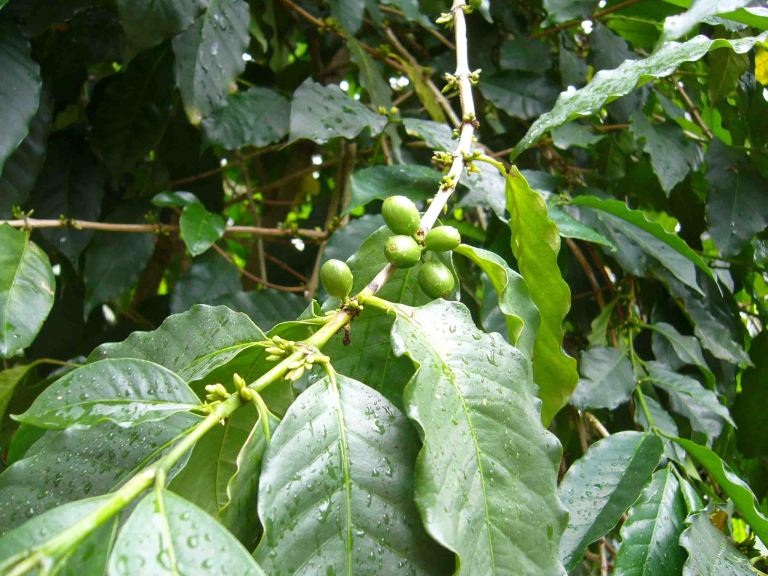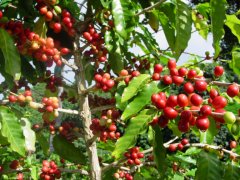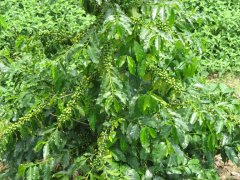Coffee planting technology: how to make coffee trees grow up quickly? Improve the success rate of planting?

Professional coffee knowledge exchange more coffee bean information please follow the coffee workshop (Wechat official account cafe_style)
What are the fruits and seeds of coffee? What the coffee beans look like.
Coffee tree, is a tropical plant, is an evergreen shrub, growing in the equator, latitude 25 degrees north and south, that is, within the Tropic of Cancer. The Tropic of Cancer and near the equator are the coffee growing belts of the world. The growth conditions require abundant rainfall and humid climate, suitable elevation of about 600 Mel 1500 meters, annual rainfall of 1500 Mel 2000 mm, mild day and cool night alternating, the average annual temperature is about 15 Mel 25 degrees, and the temperature difference between day and night is about 10 degrees. The timing of rainfall is very important, it is best to have intervals of heavy rain and strong sunshine during maturity, and a period of dry weather is needed for harvest. Any form of soil is suitable, but the best soil is a mixture of decomposed volcanic soil, humic soil and permeable soil. The soil needs to be well drained. Although the coffee tree needs irrigation, pruning, weeding, fertilization and root protection, if the soil is not the best condition for the coffee tree, it will not bear fruit for several years. The sunshine time during the day is not very long, a few hours is enough. The hillside is an ideal location because of its short viewing time and good drainage. Coffee trees like wet roots, tall trees with most leaves planted in the coffee garden, on the one hand to protect against the wind, on the other hand shade. In terms of coffee tree disasters, frost and leaf diseases are the most common killers.
Actually, coffee is very good.
Coffee seedlings (or coffee cherries) are planted in places with good drainage
Water once every three or five days
Provide a semi-shaded environment (coffee is afraid of the sun all day)
In urban areas, the balcony is actually quite suitable.
The flowerpot should be big enough (because you plant a coffee tree)
You can grow taller than a person in three years.
Compared with gardening plants, coffee is the least skillful.
If you want to plant in a large area,
Select slopes of at least 500 meters or more (usually no problem with drainage)
Generally speaking, the quality of coffee beans at high altitude is better (but this is not absolute)
Places exceeding 1000 meters should be carefully considered.
Taiwan's environment is different from that of foreign countries. Crops in Taiwan's high-altitude areas are prone to frost damage.
There should be shade trees, unless you plant them in a half-sunlit cove.
There should be plenty of water (otherwise the coffee will die in the dry season)
Fertilize. Of course, fertilizer is needed to have a good harvest (organic fertilizer).
Coffee tree, a tropical plant, is an evergreen shrub, suitable for growing in an environment of about 600m / 1500m above sea level, alternating between mild day and cool night, with an average annual temperature of about 15m / m and a temperature difference of about 10 degrees between day and night.
During the planting period, we should pay attention to whether the drainage of the soil is good and the duration of sunshine. There is no difference in using coffee beans or saplings. It depends on personal habits. When using coffee beans to plant, the success rate of planting fresh coffee beans in that year is higher.
The seeds used should be healthy and mature seeds.
The heritability of seed shape and size is high, and similar offspring can be expected to be obtained by using the selected grain size and size, but the heritability of yield is low.
Immediately after the seeds are harvested, the exocarp and pulp should be removed by hand, and the seeds with endocarp should be spread out and dried in a cool and ventilated place. Then select the complete and full seed spare coffee seed after harvest, due to the lack of dormancy, it can germinate immediately, but the germination rate will decrease rapidly with the storage time.
Under good preservation conditions, the seed can be maintained at 90-98% within three months, it will drop to 70-75% in 4-5 months, it will drop to 50% in 5 months, it will drop to about 20-25% in 9 months, but poor storage conditions will quickly reduce the germination rate. Storage in 4-7 ℃ can provide a good storage environment.
Just pick the red or even dark red and slightly dehydrated fruit of the coffee tree, and then do some treatment to wash the collected fruit, wash off the peel and pulp, leaving only the coffee beans, you will find that the color of the coffee beans will be milky white, not dark brown, this is normal, the dark brown coffee beans are the result of roasting and hot frying, and the milky white coffee beans can not be sown directly. Soak the coffee beans for about three days, change the water every day, and on the first day after soaking, you will find that there is a mucous membrane on the surface of the coffee beans. at this time, you must rub and remove the mucous membrane, and then continue to soak in water. Usually, after performing this action, change the water, once a day, until the coffee beans no longer produce mucous membranes, soak in water to clear the clean coffee beans, please put them in the shade and be really dry. At this time, you should be ready to plant. Planting should adopt the method of raising seedlings, the results will be better, seedling materials you should prepare a three-inch soft basin and a certain amount of culture soil, depending on the quantity you want to cultivate, and the method of raising seedlings, here are the following instructions:
1. First put the culture soil into a 3-inch black soft basin until it is full.
2. Fully watered until the basin floor overflowed
3. The cultivated soil will sink after watering, and the cultivated soil should be replenished until it is full.
4. and then fully watered to the basin bottom overflow.
5. Dig the planting hole in the three-inch basin soil, the size is about one nail, and the depth is about two centimeters.
6. put the dried coffee beans into the planting hole and cover them.
7. Just put it in a half-day environment.
8. Please add fungicide to the first watering after sowing.
9. In the future, the topsoil will begin to dry and replenish water.
10. Proper management should sprout in about a month.
The coffee tree is a three-to four-year-old crop. February and March of the national calendar are its florescence. Its flowers are small white flowers, which wither completely within two days to a week after flowering. After the coffee flowers fade, they will bear green fruit. Until about the lunar calendar after the Mid-Autumn Festival coffee beans from green to red began to harvest, that is, after September of the lunar calendar, Gukeng Huashan coffee entered the harvest period.
The coffee trees cultivated in Taiwan are quite wild, that is, their adaptability is quite good. So far, there are few diseases and insect pests in the coffee trees, so there is no need to spray pesticides when planting, and there is no problem of pesticide residues. This is a major advantage that Taiwan coffee can drink with peace of mind, but it consumes a lot of organic fertilizer when planting, according to the experience of coffee farmers. Usually the coffee orchard must be fertilized once a week or two so that the coffee tree will grow well and the capsule will be full.
Coffee is usually bred in a nursery, grows into seedlings, and then moved to the coffee garden a year later. In the first four or five years of its growth, the coffee tree will continue to take root downward, develop its trunk upward, and develop its branches into an umbrella shape so that it can bear rich fruit in the future.
The ideal growth environment is a temperature between 65 and 75 degrees Fahrenheit, an appropriate altitude and annual rainfall (between 40 and 120 inches). The timing of rainfall is very important, it is best to have intervals of heavy rain and strong sunshine during maturity, and a period of dry weather is needed for harvest. Any form of soil is suitable, but the best soil is a mixture of decomposed volcanic soil, humic soil and permeable soil.
The sunshine time during the day is not very long, a few hours is enough. The hillside is an ideal location because of its short viewing time and good drainage. Coffee trees like wet roots, tall trees with most leaves planted in the coffee garden, on the one hand to protect against the wind, on the other hand shade.
Although coffee trees need irrigation, pruning, weeding, fertilization and root protection, if the soil is not the best condition for coffee trees, it will not bear fruit for several years. The coffee tree grows most luxuriantly in soil filled with nitrogen, potassium carbonate and phosphoric acid. when the tree is 4-5 years old, the first fruit will soon reach its yield peak, and will continue to bear fruit if it is well cared for in 20-25 years.
.
Important Notice :
前街咖啡 FrontStreet Coffee has moved to new addredd:
FrontStreet Coffee Address: 315,Donghua East Road,GuangZhou
Tel:020 38364473
- Prev

Coffee growing conditions when is the right time to grow coffee? How to plant coffee trees?
Professional coffee knowledge exchange more information about coffee beans Please follow the coffee workshop (Wechat official account cafe_style) what are the fruits and seeds of coffee? Coffee is one of the three biggest drinks in the world, but do you know how it is grown? After learning today, the editor will tell you about planting coffee trees. The planting garden of coffee is reclaimed 1
- Next

What are the conditions for growing coffee? What are the cultivation methods of coffee trees? When to fertilize?
Professional coffee knowledge exchange more information about coffee beans Please follow the coffee workshop (Wechat official account cafe_style) what are the fruits and seeds of coffee? The appearance of coffee beans the coffee tree should not need special care, but the sunshine should be sufficient and there should be no lack of water. 1. The basic cultivation environment and management of coffee climate and native coffee are mainly limited by temperature.
Related
- Beginners will see the "Coffee pull flower" guide!
- What is the difference between ice blog purified milk and ordinary milk coffee?
- Why is the Philippines the largest producer of crops in Liberia?
- For coffee extraction, should the fine powder be retained?
- How does extracted espresso fill pressed powder? How much strength does it take to press the powder?
- How to make jasmine cold extract coffee? Is the jasmine + latte good?
- Will this little toy really make the coffee taste better? How does Lily Drip affect coffee extraction?
- Will the action of slapping the filter cup also affect coffee extraction?
- What's the difference between powder-to-water ratio and powder-to-liquid ratio?
- What is the Ethiopian local species? What does it have to do with Heirloom native species?

